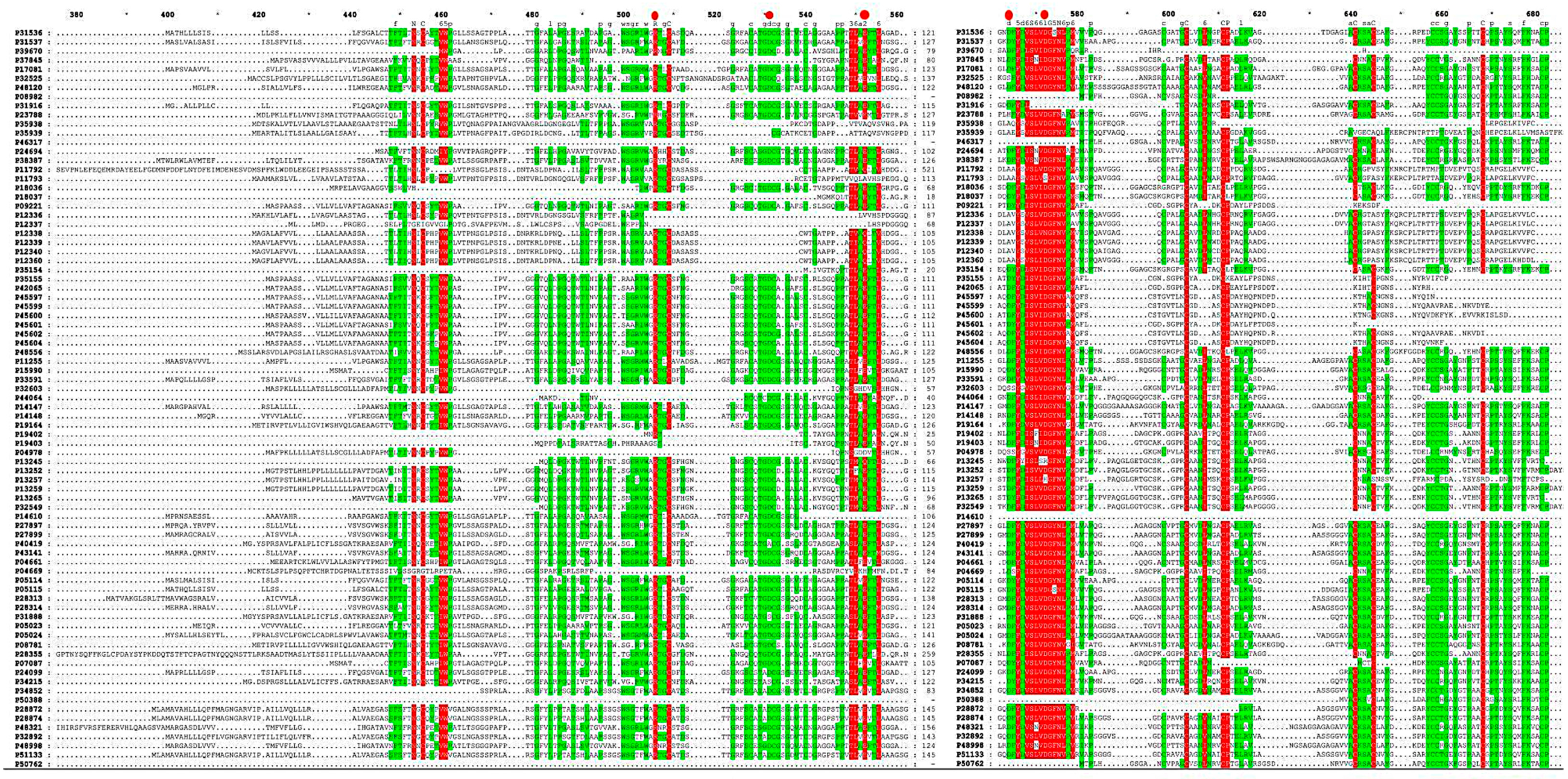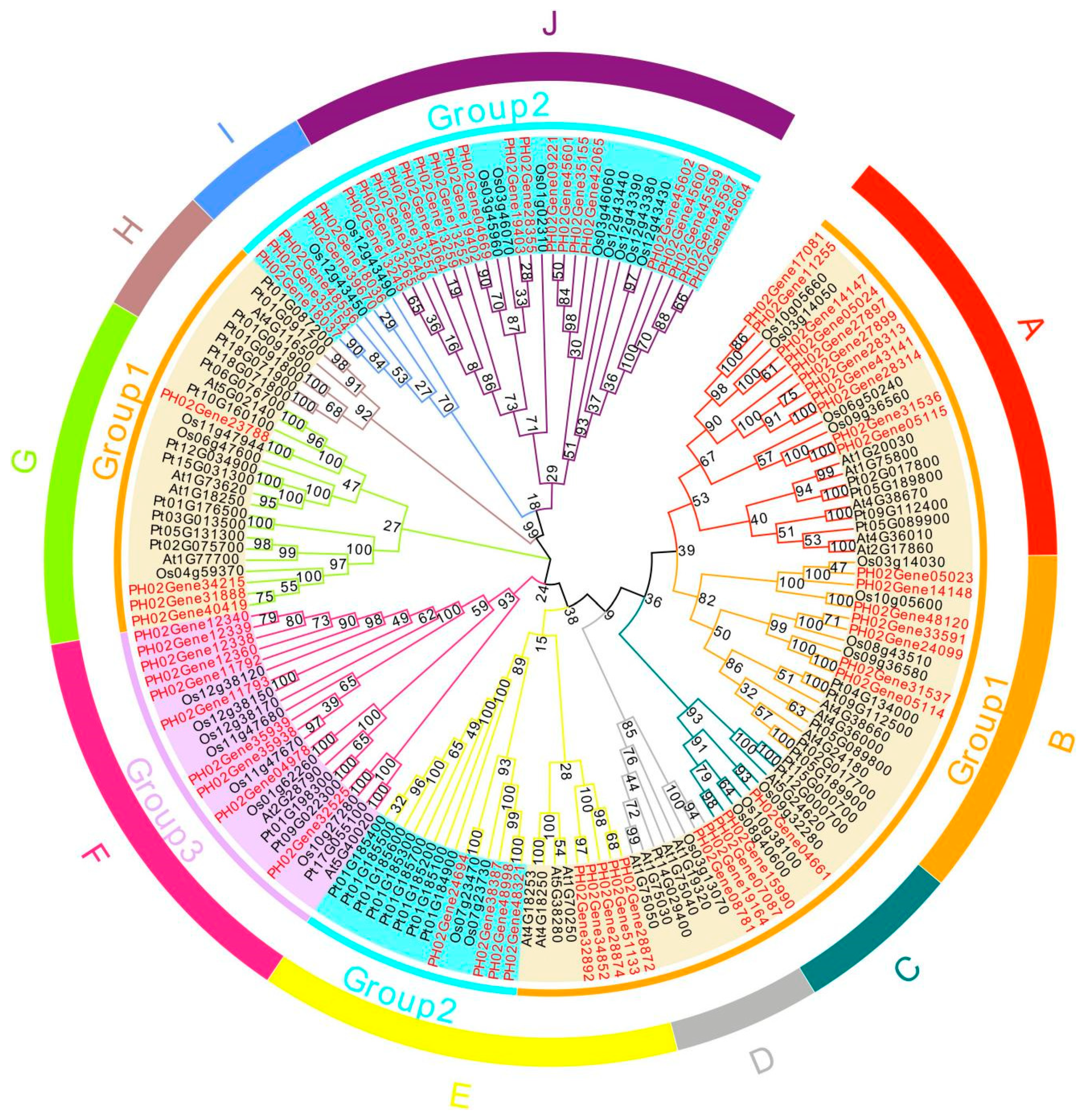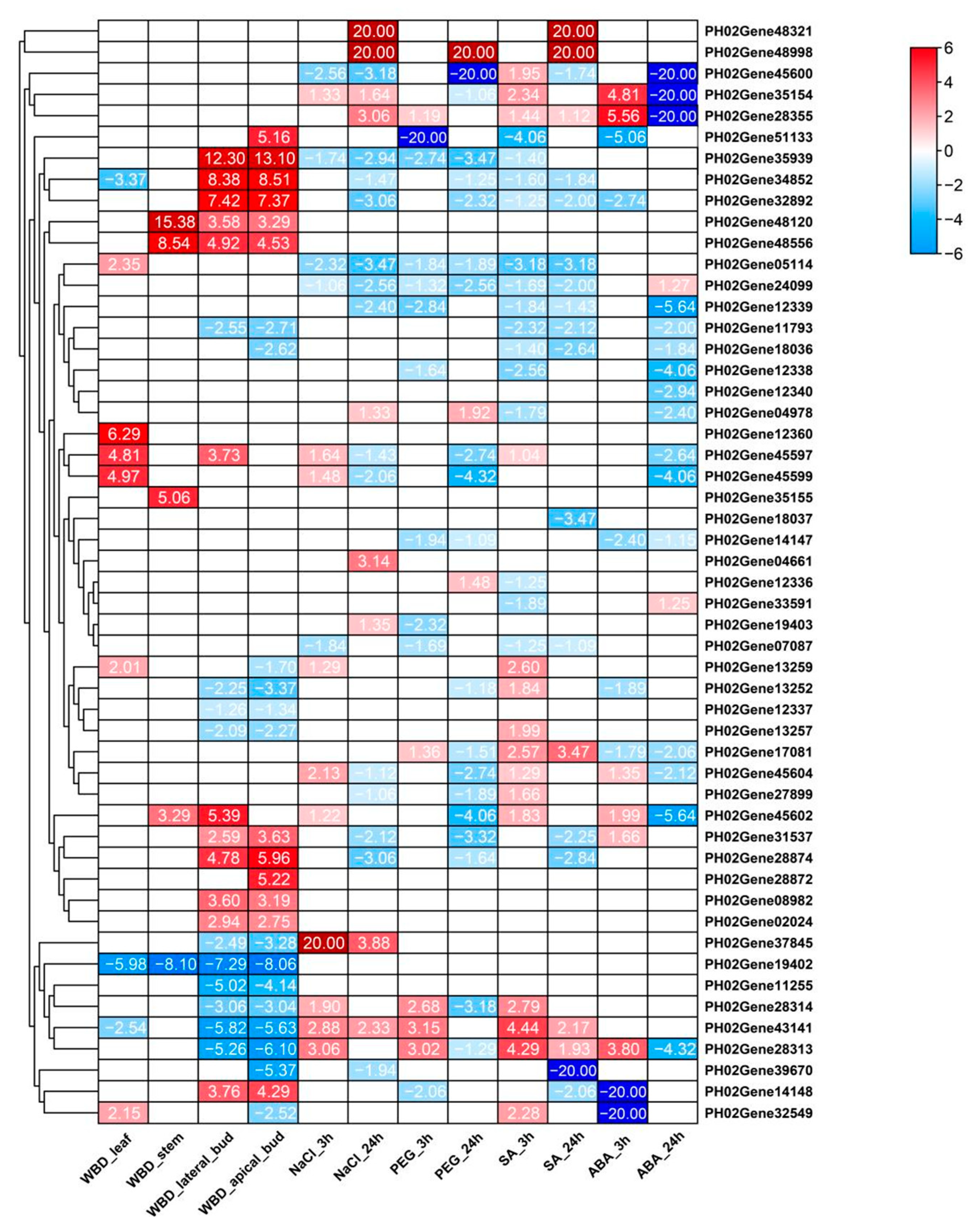Genome-Wide Identification and Characterization of the TLP Gene Family in Phyllostachys edulis and Association with Witches’ Broom Disease Resistance in Bamboo
Abstract
:1. Introduction
2. Results
2.1. Identification and Protein Characteristics of PeTLPs
2.2. P. edulis Multiple Sequence Alignment
2.3. Phylogenetic Analysis, Motifs, and Gene Structure
2.4. Evolutionary Associations between Species
2.5. Distribution of PeTLPs on Scaffolds
2.6. Interspecific and Intraspecific Gene Collinearity Analysis
2.7. Detection of cis-Regulatory Elements in PeTLPs
2.8. Transcription and Expression of PeTLPs following Pathogen Infection
2.9. Analysis of PeTLPs Gene Expression in Witches’ Broom Disease Buds via qRT-PCR
2.10. Expression Profiles of PeTLPs in Response to Abiotic Stress
2.11. Expression Profiles of PeTLPs in Response to Phytohormones
2.12. Consistency of Expression Pattern and Structure of PeTLPs
3. Discussion
4. Materials and Methods
4.1. Plant Materials
4.2. Acquisition of P. edulis Genome Information
4.3. Identification Analysis
4.4. Analyses of Protein Properties of PeTLPs
4.5. Motif, Gene Structure, and Scaffold Location Analyses
4.6. Cis-Regulatory Element Analysis
4.7. Phylogenetic Tree Construction and Synteny Analysis of PeTLP Genes
4.8. Multiple Sequence Alignment
4.9. Evolutionary Relationship and Collinearity Analysis of Different Species
4.10. Transcriptomic Data Sets to Analyze Expression Patterns of PeTLPs in Response to Phytohormones and Abiotic Stress
4.11. Expression Pattern of PeTLPs in Pathogen Infection
4.12. Protein Structure Prediction
4.13. Gene Expression Analysis
5. Conclusions
Supplementary Materials
Author Contributions
Funding
Institutional Review Board Statement
Informed Consent Statement
Data Availability Statement
Conflicts of Interest
References
- Walter, L. Bamboo and Rattan in the World. J. Bamboo Ratt. 2003, 2, 12–15. [Google Scholar]
- Selitrennikoff, C.P. Antifungal proteins. Appl. Environ. Microbiol. 2001, 67, 2883–2894. [Google Scholar] [CrossRef] [PubMed] [Green Version]
- Stintzi, A.; Heitz, T.; Prasad, V.; Wiedemann-Merdinoglu, S.; Kauffmann, S.; Geoffroy, P.; Legrand, M.; Fritig, B. Plant ‘pathogenesis-related’ proteins and their role in defense against pathogens. Biochimie 1993, 75, 687–706. [Google Scholar] [CrossRef] [PubMed]
- Sels, J.; Mathys, J.; De Coninck, B.M.; Cammue, B.P.; De Bolle, M.F. Plant pathogenesis-related (PR) proteins: A focus on PR peptides. Plant Physiol. Biochem. 2008, 46, 941–950. [Google Scholar] [CrossRef]
- Zhao, J.P.; Su, X.H. Patterns of molecular evolution and predicted function in thaumatin-like proteins of Populus trichocarpa. Planta 2010, 232, 949–962. [Google Scholar] [CrossRef] [PubMed]
- Liu, J.; Sturrock, R.; Ekramoddoullah, A.K.M. The superfamily of thaumatin-like proteins: Its origin, evolution, and expression towards biological function. Plant Cell Rep. 2010, 29, 419–436. [Google Scholar] [CrossRef]
- Park, E.J.; Kim, T.H. Thaumatin-like genes function in the control of both biotic stress signaling and ABA signaling pathways. Biochem. Biophys. Res. Commun. 2021, 567, 17–21. [Google Scholar] [CrossRef]
- He, L.; Li, L.; Zhu, Y.; Pan, Y.; Zhang, X.; Han, X.; Li, M.; Chen, C.; Li, H.; Wang, C. BolTLP1, a Thaumatin-like Protein Gene, Confers Tolerance to Salt and Drought Stresses in Broccoli (Brassica oleracea L. var. Italica). Int. J. Mol. Sci. 2021, 22, 11132. [Google Scholar] [CrossRef]
- Chen, W.L.F.Z. Arabidopsis Di 19 Functions as a Transcription Factor and Modulates PR1, PR2, and PR5 Expression in Response to Drought Stress. Mol. Plant 2013, 16, 12–15. [Google Scholar]
- Breiteneder, H. Thaumatin-like proteins—A new family of pollen and fruit allergens. Allergy 2004, 59, 479–481. [Google Scholar] [CrossRef]
- Zhang, M.; Xu, J.; Liu, G.; Yang, X. Antifungal properties of a thaumatin-like protein from watermelon. Acta Physiol. Plant. 2018, 40, 186. [Google Scholar] [CrossRef]
- Li, X.; Li, S.; Qiu, B.; Zhang, Y.; Cui, X.; Ge, F.; Liu, D. Thaumatin-like protein genes of Panax notoginseng confers resistance to Alternaria panax. Physiol. Mol. Plant Pathol. 2020, 112, 101537. [Google Scholar] [CrossRef]
- Sun, W.; Zhou, Y.; Movahedi, A.; Wei, H.; Qiang, Z. Thaumatin-like protein(Pe-TLP)acts as a positive factor in transgenic poplars enhanced resistance to spots disease. Physiol. Mol. Plant Pathol. 2020, 112, 101512. [Google Scholar] [CrossRef]
- Saeidi, M.; Zareie, R. Prediction, isolation, overexpression and antifungal activity analysis of Medicago truncatula var. truncatula putative thaumatin like proteins (TLP-1, -2, -3, -4 and -5). Turk. J. Biol. 2020, 44, 176–187. [Google Scholar] [CrossRef] [PubMed]
- Grenier, J.; Potvin, C.; Trudel, J.; Asselin, A. Some thaumatin-like proteins hydrolyse polymeric beta-1,3-glucans. Plant J. 1999, 19, 473–480. [Google Scholar] [CrossRef] [PubMed]
- Tanaka, E.; Tanaka, C.; Ishihara, A.; Kuwahara, Y.; Tsuda, M. lndole-3-acetic acid biosynthesis in Aciculosporium take, a causal agent of witches’ broom of bamboo. J. Gen. Plant Pathol. 2003, 69, 1–6. [Google Scholar] [CrossRef]
- Yan, X.; Qiao, H.; Zhang, X.; Guo, C.; Wang, M.; Wang, Y.; Wang, X. Analysis of the grape (Vitis vinifera L.) thaumatin-like protein (TLP) gene family and demonstration that TLP29 contributes to disease resistance. Sci. Rep. 2017, 7, 4269. [Google Scholar] [CrossRef] [Green Version]
- Liu, J.; Zamani, A.; Ekramoddoullah, A.K.M. Expression profiling of a complex thaumatin-like protein family in western white pine. Planta 2010, 231, 637–651. [Google Scholar] [CrossRef]
- Shatters, R.J.; Boykin, L.M.; Lapointe, S.L.; Hunter, W.B.; Weathersbee, A.R. Phylogenetic and structural relationships of the PR5 gene family reveal an ancient multigene family conserved in plants and select animal taxa. J. Mol. Evol. 2006, 63, 12–29. [Google Scholar] [CrossRef]
- Liu, Y.; Cui, J.; Zhou, X.; Luan, Y.; Luan, F. Genome-wide identification, characterization and expression analysis of the TLP gene family in melon (Cucumis melo L.). Genomics 2020, 112, 2499–2509. [Google Scholar] [CrossRef]
- Iqbal, I.; Tripathi, R.K.; Wilkins, O.; Singh, J. Thaumatin-Like Protein (TLP) Gene Family in Barley: Genome-Wide Exploration and Expression Analysis during Germination. Genes 2020, 11, 1080. [Google Scholar] [CrossRef]
- Muoki, R.C.; Paul, A.; Kaachra, A.; Kumar, S. Membrane localized thaumatin-like protein from tea (CsTLP) enhanced seed yield and the plant survival under drought stress in Arabidopsis thaliana. Plant Physiol. Biochem. 2021, 163, 36–44. [Google Scholar] [CrossRef]
- Pecenkova, T.; Pleskot, R.; Zarsky, V. Subcellular Localization of Arabidopsis Pathogenesis-Related 1 (PR1) Protein. Int. J. Mol. Sci. 2017, 18, 825. [Google Scholar] [CrossRef] [Green Version]
- Jami, S.K.; Swathi, A.T.; Guruprasad, L.; Kirti, P.B. Molecular, biochemical and structural characterization of osmotin-like protein from black nightshade (Solanum nigrum). J. Plant Physiol. 2007, 164, 238–252. [Google Scholar] [CrossRef] [PubMed]
- Min, K.; Ha, S.C.; Hasegawa, P.M.; Bressan, R.A.; Yun, D.J.; Kim, K.K. Crystal structure of osmotin, a plant antifungal protein. Proteins 2004, 54, 170–173. [Google Scholar] [CrossRef] [PubMed]
- Ghosh, R.; Chakrabarti, C. Crystal structure analysis of NP24-I: A thaumatin-like protein. Planta 2008, 228, 883–890. [Google Scholar] [CrossRef] [PubMed]
- Su, L.; Zhao, X.; Geng, L.; Fu, L.; Lu, Y.; Liu, Q.; Jiang, X. Analysis of the thaumatin-like genes of Rosa chinensis and functional analysis of the role of RcTLP6 in salt stress tolerance. Planta 2021, 254, 118. [Google Scholar] [CrossRef]
- Zhang, Y.; Chen, W.; Sang, X.; Wang, T.; Gong, H.; Zhao, Y.; Zhao, P.; Wang, H. Genome-Wide Identification of the Thaumatin-like Protein Family Genes in Gossypium barbadense and Analysis of Their Responses to Verticillium dahliae Infection. Plants 2021, 10, 2647. [Google Scholar] [CrossRef]
- Zhuang, Q. Investigation and preliminary study of the disease in Sichuan. Sicau 2005, 12, 1–23. [Google Scholar]
- Verma, V.; Ravindran, P.; Kumar, P.P. Plant hormone-mediated regulation of stress responses. BMC Plant Biol. 2016, 16, 86. [Google Scholar] [CrossRef] [Green Version]
- Tuteja, N. Abscisic Acid and abiotic stress signaling. Plant Signal. Behav. 2007, 2, 135–138. [Google Scholar] [CrossRef] [PubMed] [Green Version]
- Akbudak, M.A.; Yildiz, S.; Filiz, E. Pathogenesis related protein-1 (PR-1) genes in tomato (Solanum lycopersicum L.): Bioinformatics analyses and expression profiles in response to drought stress. Genomics 2020, 112, 4089–4099. [Google Scholar] [CrossRef] [PubMed]
- Kim, Y.S.; Park, J.Y.; Kim, K.S.; Ko, M.K.; Cheong, S.J.; Oh, B.J. A thaumatin-like gene in nonclimacteric pepper fruits used as molecular marker in probing disease resistance, ripening, and sugar accumulation. Plant Mol.Biol. 2002, 49, 125–135. [Google Scholar] [CrossRef] [PubMed]
- Gasteiger, E.; Gattiker, A.; Hoogland, C.; Ivanyi, I.; Appel, R.D.; Bairoch, A. ExPASy: The proteomics server for in-depth protein knowledge and analysis. Nucleic Acids Res. 2003, 31, 3784–3788. [Google Scholar] [CrossRef] [PubMed] [Green Version]
- Yu, C.S.; Chen, Y.C.; Lu, C.H.; Hwang, J.K. Prediction of protein subcellular localization. Proteins 2006, 64, 643–651. [Google Scholar] [CrossRef] [PubMed]
- Chengjie, C.; Hao, C.; Yi, Z.; Hannah, R.T.; Margaret, H.F.; Yehua, H.; Rui, X. TBtools: An Integrative Toolkit Developed for Interactive Analyses of Big Biological Data. Mol. Plant. 2020, 13, 1194–1202. [Google Scholar]
- Guo, A.; Zhu, Q.; Chen, X.; Luo, J. GSDS: A gene structure display server. Hereditas 2007, 29, 1023–1026. [Google Scholar] [CrossRef]
- Hu, B.; Jin, J.; Guo, A.; Zhang, H.; Luo, J.; Gao, G. GSDS 2.0: An upgraded gene feature visualization server. Bioinformatics 2015, 31, 1296–1297. [Google Scholar] [CrossRef] [Green Version]
- Hung, J.; Weng, Z. Sequence Alignment and Homology Search with BLAST and ClustalW. Cold Spring Harb. Protoc. 2016, 2016, pdb-prot093088. [Google Scholar] [CrossRef]
- Kumar, S.; Stecher, G.; Tamura, K. MEGA7: Molecular Evolutionary Genetics Analysis Version 7.0 for Bigger Datasets. Mol. Biol. Evol. 2016, 33, 1870–1874. [Google Scholar] [CrossRef] [Green Version]
- Han, Y.; Ding, T.; Bo, S.; Jiang, H. Genome-Wide Identification, Characterization and Expression Analysis of the Chalcone Synthase Family in Maize. Int. J. Mol. Sci. 2016, 17, 161. [Google Scholar] [CrossRef] [PubMed] [Green Version]
- Fionn, M.; Pierre, L. Ward’s Hierarchical Agglomerative Clustering Method: Which Algorithms Implement Ward’s Criterion? J. Classif. 2014, 31, 274–295. [Google Scholar]
- Babicki, S.; Arndt, D.; Marcu, A.; Liang, Y.; Grant, J.R.; Maciejewski, A.; Wishart, D.S. Heatmapper: Web-enabled heat mapping for all. Nucleic Acids Res. 2016, 44, W147–W153. [Google Scholar] [CrossRef]
- Waterhouse, A.; Bertoni, M.; Bienert, S.; Studer, G.; Tauriello, G.; Gumienny, R.; Heer, F.T.; de Beer, T.; Rempfer, C.; Bordoli, L.; et al. SWISS-MODEL: Homology modelling of protein structures and complexes. Nucleic Acids Res. 2018, 46, 296–303. [Google Scholar] [CrossRef] [PubMed] [Green Version]
- Singh, V.K.; Mangalam, A.K.; Dwivedi, S.; Naik, S. Primer premier: Program for design of degenerate primers from a protein sequence. Biotechniques 1998, 24, 318–319. [Google Scholar] [CrossRef] [Green Version]
- Fan, C.; Ma, J.; Guo, Q.; Li, X.; Wang, H.; Lu, M. Selection of reference genes for quantitative real-time PCR in bamboo (Phyllostachys edulis). PLoS ONE 2013, 8, e0056573. [Google Scholar] [CrossRef] [Green Version]
- Rao, X.; Huang, X.; Zhou, Z.; Lin, X. An improvement of the 2−∆∆CT method for quantitative real-time polymerase chain reaction data analysis. Biostat. Bioinform. Biomath. 2013, 3, 71–85. [Google Scholar]










| Gene ID | Length (Bp) | MW (Da) | Isoelectric Point (Pi) | Subcellular Localization |
|---|---|---|---|---|
| PH02Gene31536 | 311 | 31,406.8 | 4.88 | Extracellular |
| PH02Gene31537 | 307 | 31,499.0 | 4.41 | Extracellular |
| PH02Gene39670 | 103 | 10,757.1 | 7.34 | Extracellular |
| PH02Gene37845 | 196 | 20,776.4 | 6.21 | Extracellular |
| PH02Gene17081 | 317 | 31,191.4 | 4.25 | Extracellular |
| PH02Gene32525 | 274 | 28,569.2 | 7.90 | Extracellular |
| PH02Gene48120 | 264 | 26,727.6 | 4.39 | Extracellular |
| PH02Gene08982 | 80 | 8598.6 | 8.20 | Extracellular |
| PH02Gene31916 | 275 | 27,777.1 | 4.81 | Extracellular |
| PH02Gene23788 | 253 | 26,059.6 | 7.66 | Extracellular |
| PH02Gene35938 | 180 | 18,320.7 | 5.08 | Extracellular |
| PH02Gene35939 | 460 | 48,872.3 | 6.77 | Plasma membrane |
| PH02Gene46317 | 158 | 17,015.2 | 8.35 | Extracellular |
| PH02Gene24694 | 223 | 23,839.4 | 4.75 | Extracellular |
| PH02Gene38387 | 263 | 27,608.8 | 7.30 | Extracellular |
| PH02Gene11792 | 638 | 69,398.1 | 4.83 | Nucleus |
| PH02Gene11793 | 370 | 38,475.5 | 8.63 | Chloroplast |
| PH02Gene18036 | 207 | 21,692.0 | 4.78 | Extracellular |
| PH02Gene18037 | 136 | 14,624.4 | 5.80 | Extracellular |
| PH02Gene09221 | 161 | 16,556.4 | 4.12 | Extracellular |
| PH02Gene12336 | 203 | 21,151.1 | 7.71 | Extracellular |
| PH02Gene12337 | 184 | 19,016.6 | 4.35 | Extracellular |
| PH02Gene12338 | 215 | 22,254.4 | 8.10 | Extracellular |
| PH02Gene12339 | 208 | 21,533.5 | 6.48 | Extracellular |
| PH02Gene12340 | 213 | 22,002.0 | 6.47 | Extracellular |
| PH02Gene12360 | 214 | 22,082.9 | 6.47 | Extracellular |
| PH02Gene35154 | 138 | 14,714.5 | 5.06 | Extracellular |
| PH02Gene35155 | 172 | 17,936.2 | 8.08 | Extracellular |
| PH02Gene42065 | 168 | 17,421.4 | 4.44 | Extracellular |
| PH02Gene45597 | 170 | 17,323.1 | 4.32 | Extracellular |
| PH02Gene45599 | 180 | 18,343.2 | 4.18 | Extracellular |
| PH02Gene45600 | 184 | 18,808.0 | 4.95 | Extracellular |
| PH02Gene45601 | 156 | 15,938.7 | 3.89 | Extracellular |
| PH02Gene45602 | 178 | 18,157.3 | 7.92 | Extracellular |
| PH02Gene45604 | 172 | 17,564.5 | 4.55 | Extracellular |
| PH02Gene48556 | 244 | 25,343.4 | 8.12 | Extracellular |
| PH02Gene11255 | 322 | 31,715.2 | 4.03 | Extracellular |
| PH02Gene15990 | 341 | 34,912.6 | 4.58 | Extracellular |
| PH02Gene33591 | 315 | 32,954.2 | 4.60 | Extracellular |
| PH02Gene32603 | 180 | 19,607.2 | 7.34 | Extracellular |
| PH02Gene44064 | 133 | 14,217.2 | 8.42 | Extracellular |
| PH02Gene14147 | 320 | 31,644.4 | 5.61 | Extracellular |
| PH02Gene14148 | 327 | 33,093.0 | 4.71 | Extracellular |
| PH02Gene19164 | 258 | 26,369.3 | 5.59 | Extracellular |
| PH02Gene19402 | 142 | 15,262.9 | 4.64 | Extracellular |
| PH02Gene19403 | 167 | 17,698.4 | 4.63 | Extracellular |
| PH02Gene04978 | 194 | 20,939.8 | 6.74 | Extracellular |
| PH02Gene13245 | 298 | 32,260.4 | 7.27 | Extracellular |
| PH02Gene13252 | 643 | 70,479.9 | 7.38 | Extracellular |
| PH02Gene13257 | 607 | 66,805.0 | 7.75 | Plasma membrane |
| PH02Gene13259 | 650 | 71,573.6 | 7.15 | Plasma membrane |
| PH02Gene13265 | 218 | 22,448.2 | 8.28 | Extracellular |
| PH02Gene32549 | 308 | 32,819.8 | 7.46 | Extracellular |
| PH02Gene14610 | 106 | 10,444.6 | 8.68 | Extracellular |
| PH02Gene27897 | 301 | 30,892.5 | 6.81 | Extracellular |
| PH02Gene27899 | 257 | 26,123.8 | 4.31 | Extracellular |
| PH02Gene40419 | 287 | 30,829.8 | 8.02 | Extracellular |
| PH02Gene43141 | 313 | 31,722.3 | 4.62 | Extracellular |
| PH02Gene04661 | 322 | 33,794.7 | 4.60 | Extracellular |
| PH02Gene04669 | 168 | 17,726.9 | 8.36 | Extracellular |
| PH02Gene05114 | 304 | 31,586.1 | 4.61 | Extracellular |
| PH02Gene05115 | 314 | 31,623.1 | 4.87 | Extracellular |
| PH02Gene28313 | 326 | 33,124.9 | 4.47 | Extracellular |
| PH02Gene28314 | 310 | 32,395.1 | 5.31 | Extracellular |
| PH02Gene31888 | 284 | 30,621.7 | 8.22 | Extracellular |
| PH02Gene05023 | 334 | 33,810.0 | 5.03 | Extracellular |
| PH02Gene05024 | 337 | 34,066.3 | 4.55 | Extracellular |
| PH02Gene08781 | 259 | 26,189.2 | 4.39 | Extracellular |
| PH02Gene28355 | 376 | 39,628.9 | 4.42 | Extracellular |
| PH02Gene07087 | 319 | 32,854.0 | 4.36 | Extracellular |
| PH02Gene24099 | 320 | 33,535.0 | 4.93 | Extracellular |
| PH02Gene34215 | 285 | 30,432.4 | 7.90 | Extracellular |
| PH02Gene34852 | 270 | 27,490.5 | 4.62 | Extracellular |
| PH02Gene50388 | 104 | 11,751.2 | 8.19 | Extracellular |
| PH02Gene28872 | 245 | 25,019.8 | 5.66 | Extracellular |
| PH02Gene28874 | 271 | 27,347.4 | 4.63 | Extracellular |
| PH02Gene48321 | 285 | 29,614.1 | 7.85 | Extracellular |
| PH02Gene32892 | 270 | 27,520.5 | 4.62 | Extracellular |
| PH02Gene48998 | 253 | 25,899.9 | 6.82 | Extracellular |
| PH02Gene51133 | 271 | 27,392.4 | 4.83 | Extracellular |
| PH02Gene50762 | 158 | 17,015.2 | 8.35 | Extracellular |
Disclaimer/Publisher’s Note: The statements, opinions and data contained in all publications are solely those of the individual author(s) and contributor(s) and not of MDPI and/or the editor(s). MDPI and/or the editor(s) disclaim responsibility for any injury to people or property resulting from any ideas, methods, instructions or products referred to in the content. |
© 2023 by the authors. Licensee MDPI, Basel, Switzerland. This article is an open access article distributed under the terms and conditions of the Creative Commons Attribution (CC BY) license (https://creativecommons.org/licenses/by/4.0/).
Share and Cite
Gu, Y.; Yu, H.; He, S.; Zhang, P.; Ma, X. Genome-Wide Identification and Characterization of the TLP Gene Family in Phyllostachys edulis and Association with Witches’ Broom Disease Resistance in Bamboo. Int. J. Mol. Sci. 2023, 24, 10257. https://doi.org/10.3390/ijms241210257
Gu Y, Yu H, He S, Zhang P, Ma X. Genome-Wide Identification and Characterization of the TLP Gene Family in Phyllostachys edulis and Association with Witches’ Broom Disease Resistance in Bamboo. International Journal of Molecular Sciences. 2023; 24(12):10257. https://doi.org/10.3390/ijms241210257
Chicago/Turabian StyleGu, Yu, Haoyue Yu, Sainan He, Pan Zhang, and Xiaoping Ma. 2023. "Genome-Wide Identification and Characterization of the TLP Gene Family in Phyllostachys edulis and Association with Witches’ Broom Disease Resistance in Bamboo" International Journal of Molecular Sciences 24, no. 12: 10257. https://doi.org/10.3390/ijms241210257





